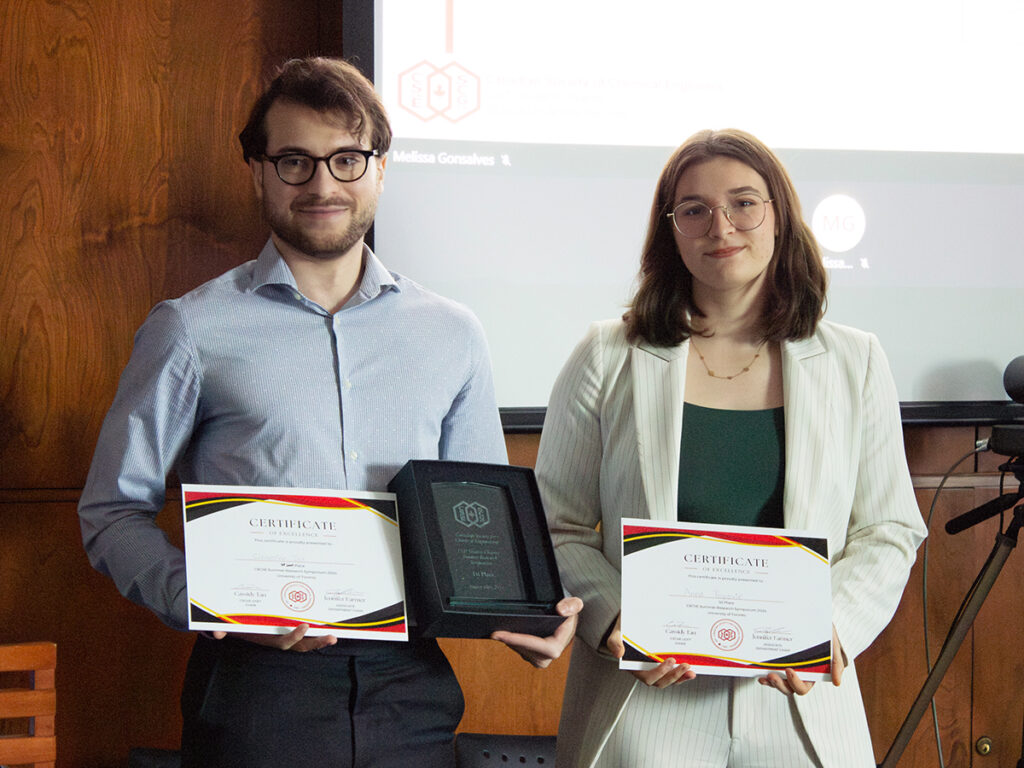On August 16th, the U of T chapter of the Canadian Society for Chemical Engineering (CSChE) held a Summer Research Symposium showcasing the work of ChemE students engaged in summer research. Attracting over a dozen participants, the symposium gave each student the opportunity to present their research in an eight-minute pitch to a distinguished panel of judges consisting of several chemical engineering professors and the chair of U of T’s Department of Chemical Engineering & Applied Chemistry.

Each presentation at the symposium demonstrated the remarkable ingenuity and dedication of ChemE’s students, reflecting their impressive depth of talent and hard work. While only one top prize was available, two students ultimately tied and were both awarded first place: Sebastian Dot (ChemE 2T6 + PEY) and Anna Popovic (ChemE 2T6). In a post-symposium interview, they were both kind enough to share some details about the focus of their projects and their research experience.

Can you explain what your research is about?
Anna: My summer research focused on developing a UV-crosslinkable conductive and porous polymer-based bioink material to be used for 3D printing high-resolution lattices that can better model the Purkinje fibre network, which plays a significant role in the propagation of electrical impulses in the myocardium (heart muscle). Following the bioink’s development, my work focused on assessing its performance in extrusion-based 3D printing, its ability to recapitulate native cardiac tissue properties, and its overall cell and tissue compatibility to ensure viability for applications in cardiac tissue engineering and in-vitro organ-on-a-chip technologies.
Sebastian: My research aims to develop a new method of producing ultrapure water using ultrathin filtration membranes.
Can you explain the social value/utility of your work?
Anna: Cardiovascular disease continues to be a leading cause of death worldwide. Advancements in studying these conditions and developing new therapies for myocardial
repair and regeneration heavily rely on the development of biomaterials that accurately replicate the physiology of the native myocardium. This includes its viscoelastic and electromechanical proprieties and permeability for eKective mass transfer. Once fully assessed, our bioink can be used in the fabrication of in-vitro heart-on-a-chip models and cardiac patches to repair the heart tissue post-myocardial infarction, which often results in the formation of non-contractile and non-conductive scar tissue.
Sebastian: My work could make producing ultrapure water more efficient and affordable, which is essential for industries like nuclear power, semiconductor manufacturing, and pharmaceuticals.

What is unique or novel about your approach/techniques?
Anna: Most groups 3D print structures using hydrogels, which deform easily under the heart’s contractile forces. Other groups use rigid polymers, which are too stiff for soft tissue applications. Our work is novel in that we use composite elastomeric biopolymers to create versatile, conductive, and porous structures, making them ideal for soft tissue engineering applications. Additionally, by using 3D printing techniques, we pave the way for scaling up the production of high-resolution organ-on-a-chip devices and scaffold technologies. Making these technologies widely available for cardiac research and therapeutic applications—such as disease modelling, drug testing, and developing regenerative therapies— will accelerate advancements in research and clinical practices, ultimately leading to better patient outcomes.
Sebastian: I made water filtration membranes using spherical nanoparticles linked together, a method that hasn’t been tried before. This approach can be scaled up (which is crucial for industry) and allows for a variety of materials to be used for membrane formation.
Was there anything surprising/unexpected you learned during this process?
Anna: Research is not a linear process. It’s dynamic, iterative, and sometimes messy –machines break down, and hypotheses can be proven wrong. But I always remember that every action is a step forward. If research were straightforward, we’d know the answer to all the world’s biggest questions by now, and where’s the fun in that? So, I revel in the successes, learn from the setbacks, and keep discovering.
Sebastian: I learned a lot about polymer and nanoparticle science and was amazed by how these fields can create impactful and practical technologies. It was exciting to discover that the difference between the technology of today and the future may only just be a couple of chemical reactions away.